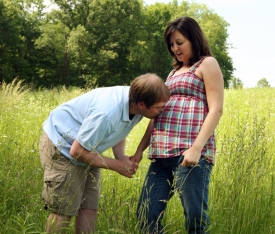 Remember that hopeful young boy saying he wanted seven sons and seven daughters when he grew up? Or that family that had five girls and was longing for a baby boy? Their hopes don’t have to be in vain! They may or may not realize that they do have other options. In the past couple years, planning parenthood has become a step easier. If and when to have children has “safely” been up to parents for about sixty years now, but what to have (as a “safe” idea) has only been around for a couple of years.
Remember that hopeful young boy saying he wanted seven sons and seven daughters when he grew up? Or that family that had five girls and was longing for a baby boy? Their hopes don’t have to be in vain! They may or may not realize that they do have other options. In the past couple years, planning parenthood has become a step easier. If and when to have children has “safely” been up to parents for about sixty years now, but what to have (as a “safe” idea) has only been around for a couple of years.
Recent studies are showing, though, that at this point, only eight percent of parents would want to use available technology to pre-select their baby’s gender. Research done on United States fertility clinics—half of which are offering the option of choosing the gender of the baby—show that “sex selection” without any medical reason to warrant it was performed in only about nine percent of all embryo screenings last year. The popularity of this procedure is likely to increase, however, as long as parents increasingly see nothing wrong with “toying with nature,” or taking matters into their own hands.
Of course, you know at least one family with four boys or six girls longing for a baby of the other gender? The Millers were one of those families. Parents Shane and Sharla had three boys, and with each birth, Sharla kept hoping for a girl. Wanting a guarantee that her next child would be a girl, Sharla looked into adoption. This was when she stumbled across the website of “The Fertility Institutes,” a site belonging to fertility doctor Jeffrey Steinberg. Through an in vitro fertilization (sound familiar?) technique called pre-implantation genetic diagnosis (PGD), Dr. Steinberg could guarantee the gender of the Millers’ baby. This technology was created to discover some embryos with dangerous and possibly lethal genetic diseases. It can also be used to choose the gender of children, not the direction the creator of this technique had in mind.
To Sharla Miller, however, PGD was a dream come true as she wanted a girl after having three boys. In November, Dr. Steinberg fertilized Sharla’s eggs in a lab dish, producing fourteen healthy embryos, seven male and seven female. He took the embryos that he wanted—three of the females—and implanted them into Sharla’s uterus. Nine months after this long, expensive procedure, “Natalie Miller” was born. She had cost the Millers $18,840, but yes, they had their girl.
While many grateful families have showered their praise on the PGD procedure, a lot of people are concerned that with this technique, science is crossing a line that should not be crossed. “If couples can request a baby boy or a baby girl,” writes Claudia Kalb, in her “Brave New Babies” article in the health section of Newsweek, “what’s next on the slippery slope of modern reproductive medicine? Eye color? Height? Intelligence?”
In most countries it is illegal to use embryo selection in order to choose the sex of your child, but not so in the United States where it is legal and not even regulated. Dr. Mark Hughes, founder of PGD, is especially concerned. He said that if you have the technical ability to do something, doesn’t mean you have to it. Other fertility specialists are divided over the issue.
Not only are scientists playing with life in lab dishes, but also what happened to God choosing what children couples should have? When this question was brought up to Sharla Miller, she insisted that she did not feel like she or the doctors were playing God. She said it is like any other medical procedure.
But diseases and illnesses have always been recognized as problems needing treatment—children are a gift from God! Doesn’t God know far better than man whether boys or girls would be better for each couple, and aren’t they a blessing regardless of their gender? Many people are saying they simply “feel uncomfortable” with PGD, and would rather leave the gender of their baby “up to chance,” but it’s really more serious than that. By paying thousands of dollars to get the kind of baby that we want, we are denying God’s wisdom of what is best for us.
